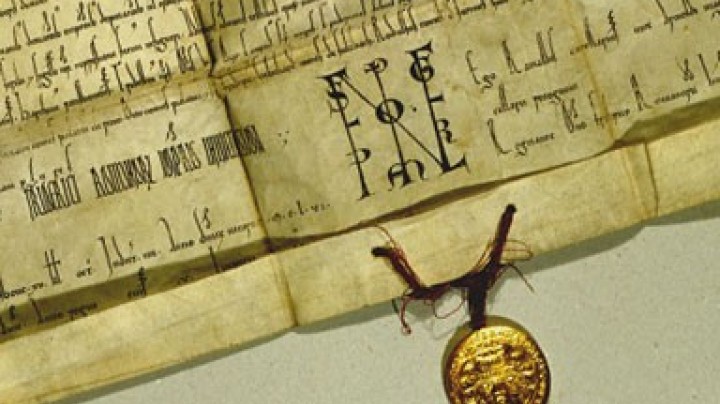Ladislaus the Posthumous: the child-king
The only male offspring of Albrecht V was born four months after his father’s unexpectedly early death, a circumstance that led to his byname 'the Posthumous'.
Even at his birth Ladislaus united a range of claims in his person. The newborn infant was not only heir to the Austrian lands of the Albertine branch of the Habsburgs but also aspirant to the crowns of Hungary and Bohemia. The latter claim came from his mother Elizabeth, daughter of Emperor Sigismund, who had succeeded in uniting the two kingdoms under his rule. It was also his resolute and proactive mother Elizabeth who defended the hereditary claims of her small son in the Luxembourg kingdoms until her death in 1442, as the turbulent circumstances of the time militated against the enforcement of these claims.
In Hungary the infant had been acclaimed king by his mother when he was only twelve weeks old, after she had brought the Crown of St Stephen into her possession in a highly adventurous manner. However, the Estates favoured the Polish king Ladislaus III Jagiello, who held out the prospect of a strong kingdom in a time when the Ottoman advance into the Balkans threatened to become a danger for Hungary. Ladislaus III fell against the Turks in the Battle of Varna in present-day Bulgaria in 1444. It was then that Ladislaus, now aged four, was recognized as king. Actual power, however, lay in the hands of the regent János Hunyadi, who officially represented the child-king but was in fact the driving force behind Ladislaus’s waning influence on Hungarian affairs.
The situation was similar in Bohemia: the land was suffering from the consequences of the Hussite revolution. The contentious issue of Ladislaus’s claim to the throne made for additional complications. Here too real power ended up in the hands of a regent appointed by the Estates, George of Podiebrad.
After the death of his mother, Duke Frederick V (from 1452 Emperor Frederick III), now the most senior member of the House of Habsburg, became Ladislaus’s guardian and thus upholder of the young boy’s hereditary claims which were some day to make a powerful monarch out of him. Frederick saw in Ladislaus a pawn that he could use to influence his rule in Austria. However, he had little chance of defending the child’s claims to Bohemia and Hungary, something that the pragmatic Habsburg soon realized. Ladislaus was here only a trump card in Frederick’s quarrel with his neighbours, as the unresolved question of the claims to the throne led to persistent running battles on the borders of Austria with Hungary and Bohemia.
Frederick resisted the repeated demands of the Estates in Austria, Hungary and Bohemia to hand over the young boy, whom they recognized as their only ‘natural lord’ and wished to have under their protection. In 1451 the Austrian Estates formed the League of Mailberg as a platform of opposition against Frederick which was supported by a majority of the nobility.
In 1452, having only recently returned from his coronation as emperor in Rome, and having been besieged in Wiener Neustadt by a combined force of troops supplied by the Austrian, Bohemian and Hungarian Estates, Frederick was finally forced to surrender Ladislaus.
Now aged twelve, Ladislaus was installed as ruler in Vienna. Here too a representative held the real power in his hands in the name of the Estates: this was Ulrich von Eyczing, who was in charge of the financial administration of the land.
Having hitherto been a merely passive object in the plans of others, Ladislaus began to take an active political role as soon as he gained his majority. He dismissed Eyczing and appointed Ulrich of Cilli, his maternal uncle, as his first counsellor, in effect making him regent over Austria.
However, when Ladislaus also gave the Count of Cilli – who had previously actively interfered in Hungary’s affairs – the title of governor in Hungary, the hitherto all-powerful family of the recently deceased János Hunyadi feared that they would lose their influence. In 1456 Ulrich of Cilli was murdered in Belgrade by László, the elder of Hunyadi’s two sons. Ladislaus had the assassin arraigned and executed in 1457. This did not serve to strengthen his position with the consequence that he was forced to quit Hungary in the face of waning support from the Hungarian nobility.
In the same year Ladislaus set out for Prague to acceded to his rule in Bohemia and to meet the bride that had been chosen for him, Magdalena, a daughter of the French king Charles VII. Shortly after his arrival he died suddenly at the age of just seventeen. There were immediate rumours that he had been poisoned by George of Podiebrad, who had little interest in the presence of the king within his dominion. Other contemporary accounts give plague as the cause of his death. It was not until his remains were autopsied in 1985 that leukaemia was revealed as being the true reason for his death.
Since Ladislaus had died unmarried and childless, the Albertine line of the Habsburgs became extinct. The attempt to secure the crowns of Hungary and Bohemia for the dynasty had failed for the time being. The young king was interred in the royal crypt in St Vitus’s Cathedral in Prague.














